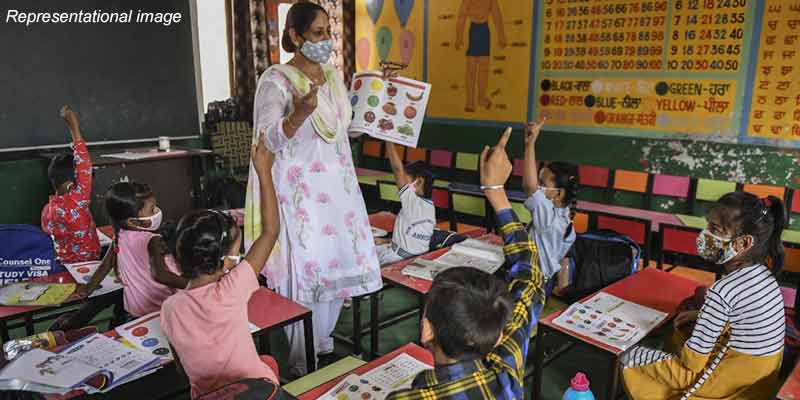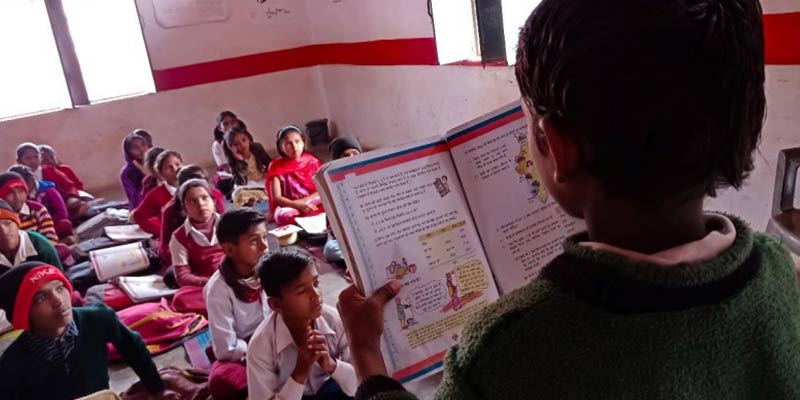- India
- Jan 19
Sharp drop in children’s basic reading ability, finds ASER 2022
The basic reading ability of school students across all classes has dropped to pre-2012 levels while basic maths skills have declined to 2018 levels, according to the Annual Status of Education Report (ASER), 2022.
It showed that the drops are visible in government as well as private schools in most states and for both boys and girls.
While the maximum drop in reading abilities has been seen in states such as Kerala, Himachal Pradesh and Haryana, the drop in maths skills has been seen in Tamil Nadu, Mizoram and Haryana.
ASER 2022
• The Annual Status of Education Report (ASER) 2022, by Pratham Foundation, is a nationwide citizen-led household survey that provides a snapshot of children’s schooling and learning in rural India.
• ASER 2022 reached almost all rural districts of India, and generated district, state and national level estimates of children's enrolment status and foundational skills.
• Information about enrolment in school or preschool was collected for all children aged 3-16, and children aged 5-16 were tested one-on-one to understand their reading, arithmetic and English skills.
• The first ASER was conducted in 2005 and repeated annually for ten years. In 2016, ASER shifted to an alternate-year cycle in which the ‘basic’ nationwide ASER alternated with a smaller survey (1-2 districts per state) focusing on other age groups and dimensions of learning.
• ASER 2022 is the first field-based ‘basic’ nationwide ASER after a gap of four years. It comes at a time when children are back in school after an extended period of school closure. Evidence on the status of children’s schooling and foundational learning will help us understand how best to support them going forward, and ASER 2022 attempts to address this urgent need.
• For the latest study, 699,597 children from 374,544 households in 19,060 villages across 616 districts were covered in field visits.
Highlights of ASER 2022
Enrolment and attendance
• The enrolment rate for the 6 to 14 age group has been above 95 per cent for the past 15 years. Despite school closures during the pandemic, overall enrolment figures have increased from 97.2 per cent in 2018 to 98.4 per cent in 2022.
• The period 2006 to 2014 saw a steady decrease in the proportion of children (age 6 to 14) enrolled in government school. In 2014, this figure stood at 64.9 per cent and did not change much over the following four years. However, the proportion of children (age 6 to 14) enrolled in government school increased sharply from 65.6 per cent in 2018 to 72.9 per cent in 2022. Increase in government school enrolment is visible for almost every state in the country.
Paid private tuition classes
• Over the past decade, rural India has seen small, steady increases in the proportion of children in Classes 1-8 taking paid private tuition classes. Between 2018 and 2022 this proportion increased further, among students in both government and private schools.
• Nationally, the proportion of children in Classes 1-8 taking paid private tuition classes increased from 26.4 per cent in 2018 to 30.5 per cent in 2022. In Uttar Pradesh, Bihar, and Jharkhand, the proportion of children taking paid private tuition increased by 8 percentage points or more over 2018 levels.
Foundational skills in reading and arithmetic
• The ASER reading test assessed whether a child can read letters, words, and a simple paragraph at the Class 1 level of difficulty, or a story at the Class 2 level of difficulty. The test was administered one on one to all children in the age group of 5-16 in sampled households. Each child was marked at the highest level that she or he can reach comfortably.
• The percentage of children in Class 3 in government or private schools who can read at Class 2 level dropped from 27.3 per cent in 2018 to 20.5 per cent in 2022. This decline is visible in every state and for children in both government and private schools.
• States showing a decline of more than 10 percentage points from 2018 levels include those that had higher reading levels in 2018, such as Kerala (from 52.1 per cent in 2018 to 38.7 per cent in 2022), Himachal Pradesh (from 47.7 per cent to 28.4 per cent), and Haryana (from 46.4 per cent to 31.5 per cent).
• Huge drops are also visible in Andhra Pradesh (from 22.6 per cent to 10.3 per cent) and Telangana (from 18.1 per cent to 5.2 per cent).
• Nationally, the proportion of children enrolled in Class 5 in government or private schools who can at least read a Class 2-level text fell from 50.5 per cent in 2018 to 42.8 per cent in 2022. States where this indicator held steady or improved marginally include Bihar, Odisha, Manipur, and Jharkhand.
• States showing a decrease of 15 percentage points or more include Andhra Pradesh (from 59.7 per cent in 2018 to 36.3 per cent in 2022), Gujarat (from 53.8 per cent to 34.2 per cent), and Himachal Pradesh (from 76.9 per cent to 61.3 per cent). Drops of more than 10 percentage points are visible in Uttarakhand, Rajasthan, Haryana, Karnataka, and Maharashtra.
• Although drops in basic reading ability are visible among Class 8 students as well, these are smaller as compared to observed trends in Classes 3 and 5.
• Nationally, 69.6 per cent of children enrolled in Class 8 in government or private schools can read at least basic text in 2022, falling from 73 per cent in 2018.
• Children’s basic arithmetic levels have declined over 2018 levels for most grades across the country. But the declines are less steep and the picture is more varied than in the case of basic reading.
• The all-India figure for children in Class 3 who can at least do subtraction dropped from 28.2 per cent in 2018 to 25.9 per cent in 2022.
• While Jammu & Kashmir, Uttar Pradesh and Madhya Pradesh maintained or improved slightly over 2018 levels, steep drops of more than 10 percentage points are visible in Tamil Nadu (from 25.9 per cent in 2018 to 11.2 per cent in 2022), Mizoram (from 58.8 per cent to 42 per cent), and Haryana (from 53.9 per cent to 41.8 per cent).
• The proportion of children in Class 5 across India who can do division has also fallen slightly, from 27.9 per cent in 2018 to 25.6 per cent in 2022.
• While Bihar, Jharkhand, Meghalaya and Sikkim show slight improvements over 2018 levels, steep drops of more than 10 percentage points are visible in Mizoram (from 40.2 per cent in 2018 to 20.9 per cent in 2022), Himachal Pradesh (from 56.6 per cent to 42.6 per cent), and Punjab (from 52.9 per cent to 41.1 per cent) among others.
• The performance of Class 8 students in basic arithmetic is more varied.
• Nationally, the proportion of children who can do division has increased slightly, from 44.1 per cent in 2018 to 44.7 per cent in 2022. This increase is driven by improved outcomes among girls as well as among children enrolled in government schools, whereas boys and children enrolled in private schools show a decline over 2018 levels.
• Children in Class 8 in government schools did significantly better in 2022 than in 2018 in Uttar Pradesh (from 32 per cent to 41.8 per cent) and Chhattisgarh (from 28 per cent to 38.6 per cent), but significantly worse in Punjab (from 58.4 per cent to 44.5 per cent).
Manorama Yearbook app is now available on Google Play Store and iOS App Store




